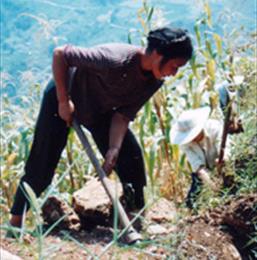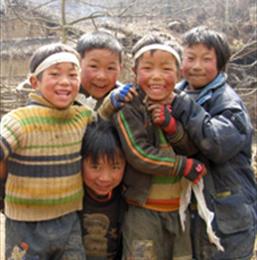Integrated Village Projects
DORS has implemented a series of integrated village based projects. As the needs are different in each village, DORS works closely with the village to come up with a plan of a series of component projects that help improve living conditions. Please see the links below for details of each village project.
Integrated Rural Community Development Projects
DORS began considering implementing integrated community projects in 2001. We found that doing one or two projects by themselves didn’t have a big effect on improving the village’s total situation, because this didn’t help villagers understand DORS’working ideas or methods, seeking together after the village's sustainable development and their own. From the perspective of a whole village’s development, we consider villages’ individuality and specific requests to develop projects. The aim is to link different projects together, and through that, to achieve the effect of projects complementing each other.
We discovered that a village’s poverty is caused by many factors, and according to these factors as well as villagers’ requests, through considering together with villagers and researching with them, together we design development projects suited to the village. What projects to implement is mainly decided by the villagers, our role being an assistant and source of references, suggestions and analysis. This way of considering a series of linked projects for a village’s comprehensive development, we call integrated projects. Usually a village’s integrated projects plan is implemented over the course of three years.
Example Project
Below are Maping Village’s integrated project’s components.
Supported a part of building the road to the village, which made it easier for villagers to get to market and traders to come to buy goods. This will gradually raise their income.
Provided clean, convenient community-managed drinking water, and in so doing improved the sanitation of living and production for villagers.
Helped especially poor households connect to electricity, who previously didn’t have the ability
Supported school fees for particularly poor children in order to confirm that this generation of children would still have the chance to receive primary school education
Provided saplings and training to households in order to improve the environment, increase villagers’ income through sale of nuts/fruit, and at the same time to improve households’ management ability and increase firewood resources
In order to increase the yields of nuts and fruit for villagers, and improve the management of the trees, we go to villages and give forestry training classes for interested villagers.
In areas lacking in firewood, we implement fuel-efficient stoves and biogas systems projects, at the same time helping villagers save time and labor
For women, implementing a micro-loan project, specifically to generate income for them, for example, through developing animal husbandry, expanding varities of agricultural production, etc. ·
Particularly poor households project. We specially do certain micro-projects for these people who lack care, for example: improving their houses, supporting their children going to school by paying school fees, etc. Seeking the opinions and suggestions of often overlooked groups such as individually poor families is an important part of this project.
Project Effectiveness
1. Basic Infrastructure. Through roads, establishing water systems, connecting to electricity, etc., we practically solved some of villagers’ production and living conditions problems. The difference before and after the project is quite obvious—from not having to having these facilities.
2. Rural energy projects. Fuel-efficient stoves and biogas’s construction absolutely reduce the number of trees cut for firewood, save labor, etc. Stoves already save half of the fuelwood, and the time spent cooking (because the fire is hotter) is reduced by 1/2 to 1/3. The surface of the stove is tile, which makes the kitchen much more sanitary, and the stoves’ releasing smoke outside prevents harm to women’s health, especially their eyes. These are the primary effects. Secondarily, villagers gradually come to realize the environment’s effects on them, for example: mud- and rock slides, having to go ever further to collect firewood, etc. Besides this we trained 6 villagers to be technicians for building the stoves, along with one biogas technician. They have already learned this technology well, and can do the projects independently.
3. Education project. We supported children attending school, and in the whole village there are no children out of school.
4. Women’s micro-credit loan project. The majority of the women use these funds to buy pigs to raise, or do some small-scale business. It gives the family some extra cash flow.
5. Forestry. We planted cherry, peach, sweet cherry, grape, pear, loquat, etc. saplings, as an “economic forestry” project, altogether spending 38,875 yuan. At present, the benefits aren’t pronounced—some households’ cherry trees have started to produce 2-3 cherries. We constructed 102 water cisterns, trained 5 village-level technicians up to standard, and they will pass on the knowledge to the rest of the village. Of all the trees, cherries and loquats’ maturity rates are high, reaching 90% and above. We estimate next year the cherry trees will be able to produce fruit—the peach trees, because the variety is good, already produced fruit this year. Sichuan pepper and plum trees, and grapevines, turned out to mature poorly, but we didn’t plant many of them.
6. Particularly poor households project. We changed living conditions for four particularly poor households. We increased the activeness of these households in participating in projects, they are very happy to express their opinions now.
DORS completed 9 projects in 7 hamlets in 23 months, as described above in Maping Village’s Integrated Project, of which forestry for example is a long-term project, so DORS does follow-up work and monitoring after the project.
Interrelated effectiveness
one project’s influence is relatively weak and limited, for example: women’s loans are aimed only at women. Villagers’ needs are many, and usually, according to households’ ability, finances and requests, different. Through different kinds of projects DORS aims to 1) improve living conditions and increase income, for practical effectiveness; and 2) by continuously searching to find good ways to develop together by themselves.
Influence
Through the weaving together of projects, villagers continuously come to understand DORS’ development ideas and participatory methods. From the process of project implementation you can see: Villagers come to see the necessity of management small groups, gradually come to see that funds use on projects is transparent and open, and that women and the elderly, etc. disadvantaged groups need to participate, etc. Before, our strict management and monitoring of projects led villagers to be passive to the point where they only brought up all the problems with the project, but now villagers, given more responsibility for projects, actively take a managerial role, and bring up problems that could arise early on. This is a process of going from reliance to self-reliance and self-awareness, and is a thing we are most gratified to see in our projects.
Sustainability
The projects DORS implements belong to the village. At the same time, after DORS involvement ceases, having the villagers continue to consciously maintain and protect their own projects as well as obtain the ability to manage and implement projects, is DORS’ final goal—that villagers independently develop themselves.


